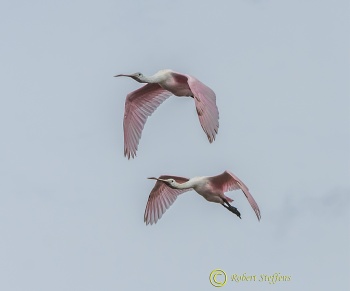- Platalea ajaja
Ajaia ajaja
Identification
30-32 in (76-81 cm) tall
Ws. 4ft 5in (1.3m)
- Unmistakable
- Long-legged, long-necked
- Long, spatulate bill
Adult
- Bare greenish head
- White neck, breast, and back
- Deep pink otherwise
- Grey bill
- Rich crimson shoulder
- Orange tail
Sexes similar
Immature
- White feathered heads
- Paler pink
- Yellowish or pinkish bill
Distribution
It is a mainly resident breeder in South America, the Caribbean, and the Gulf coast of the USA.
Early in the 20th century their numbers were severely depleted by plume hunters, but with protective laws they have increased once again.
Taxonomy
This is a monotypic species[1].
Platalea vs. Ajaia
Many authorities (AOU, 2002; SACC, 2003; Clements, 2005) have placed this lone species in Platalea in light of Hancock et al. (1992) and Banks et al. (2002). Sibley & Monroe (1996) and Howard & Moore (2003) retain Roseate Spoonbill's monotypic placement in Ajaia.
Habitat
Nests in mangrove trees.
Behaviour
A banded bird was found to be 16 years old in 2006, the oldest known individual.
Breeding
The clutch consists of 2-5 eggs. It does not usually share colonies with storks or herons.
Diet
These birds spend much time feeding in the shallow waters of Florida Bay and the Gulf of Mexico on shrimp, small fish, snails, and aquatic insects, which they detect by their sense of touch as they rhythmically sweep their "spoon-shaped" bills from side to side as they walk steadily through the water, often in groups.
Vocalisation
Low croaks and clucking sounds.
References
- Clements, J. F., T. S. Schulenberg, M. J. Iliff, D. Roberson, T. A. Fredericks, B. L. Sullivan, and C. L. Wood. 2018. The eBird/Clements checklist of birds of the world: v2018. Downloaded from http://www.birds.cornell.edu/clementschecklist/download/
- Search.com
Recommended Citation
- BirdForum Opus contributors. (2025) Roseate Spoonbill. In: BirdForum, the forum for wild birds and birding. Retrieved 19 April 2025 from https://www.birdforum.net/opus/Roseate_Spoonbill
External Links
GSearch checked for 2020 platform.1






